Planetary, synoptic, meso-alpha, meso-beta, local, and more—there are atmospheric scales aplenty discussed at AMS meetings. Enter microtopography, a once-rare word increasingly appearing in the mix in research (for example, here and here).
The word is also coming up as researchers are getting new tools to examine the interaction of tornadoes with their immediate surroundings. Microtopography looks like a potential factor in tornadic damage and in the tornadoes themselves, according to an AMS Annual Meeting presentation by Melissa Wagner (Arizona State Univ.) and Robert Doe (Univ. of Liverpool), who are working on this research with Aaron Johnson (National Weather Service) and Randy Cerveny (Arizona State Univ). Their findings relate tornado damage imagery to small changes in local topography thanks to the use of unmanned aerial systems (UASs).
Microtopographic interactions of tornadic winds were captured in their UAS imagery. Here’s the 5-meter resolution RapidEye satellite imaging of a 30 April 2017 Canton, Texas, tornado path (panel a) versus higher-resolution UAS imaging:
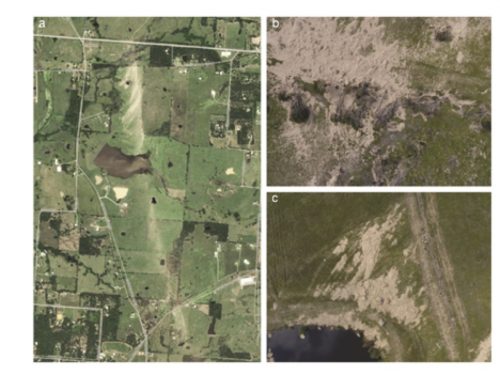
The UAS surveys show that tornadic winds interact with sunken gullies, which appear as unscarred, green breaks (circled in red) in the track of browned damaged vegetation:
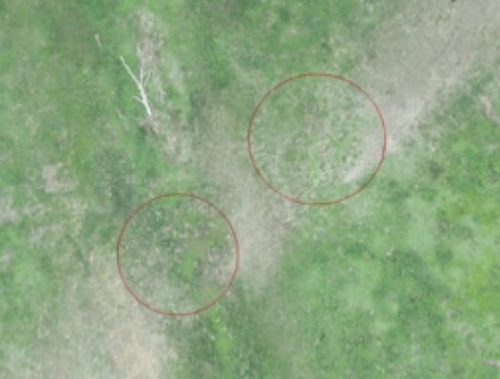
Erosion and scour are limited within the depressed surfaces of the gullies compared to either side. In another section of the track, track width increases with an elevation gain of approximately 74 feet, as shown in a digital elevation model and 2.5 cm resolution UAS imagery:
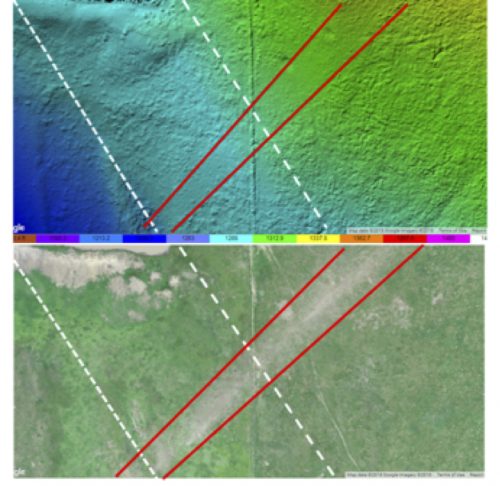
The advent of unmanned aerial vehicles (UAVs) has opened new windows on tornado damage tracks. Decades ago, damage surveys took a big leap forward with airplane-based photography that provided a perspective difficult to achieve on the ground. Satellites also can provide a rapid overview but in relatively low resolution. UASs fly at 400 feet—and are still limited to line-of-sight control and the logistics of coordinating with local emergency and relief efforts, regulatory and legal limitations, not to mention still-improving battery technology.
However, UASs provide a stable, reliable aerial platform that benefits from high-resolution imaging and can discern features on the order of centimeters across. Wagner and colleagues were using three vehicles with a combined multispectral imaging capability that is especially useful in detecting changes in the health of vegetation. As a result their methods are being tested primarily in rural, often inaccessible areas of damage.
UAS technologies thus can capture evidence of multi-vortex tornadoes in undeveloped or otherwise remote, vegetated land. The image below shows a swath with enhanced surface scour over two hills (marked X). The arrow on the right identifies speckled white surface erosion, part of the main tornado wedge. Such imagery explains why, among other research purposes, Wagner and Doe are developing the use of UASs in defining tracks and refining intensity-scale estimates.
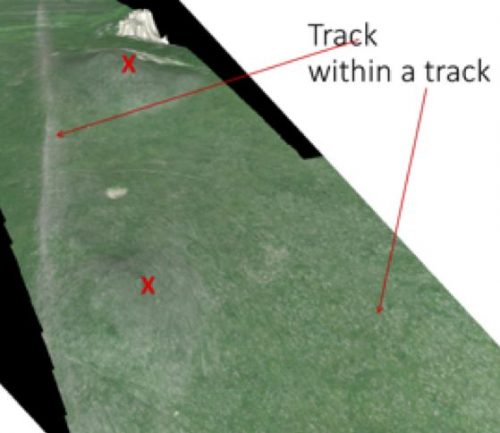
AMS2019
Is It Sand Or Is It Snow?: Nuggets from Today's Poster Session
Today’s poster sessions starting at 4 p.m. will full of mysterious images. This is your opportunity to ask the researchers what the pictures are all about.
In the case of Morristown-Beard School sophomore Kim Magnotta’s poster (103) today, the question may be simply, what are pictures of sand doing at a meteorology conference?
There’s a good reason, of course, so go ahead and ask.
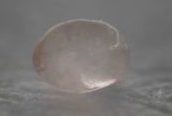
Magnotta jumped into microphotography hoping to capture images of snowflakes falling on Northern New Jersey. Starting her work during summer vacation, finding snow was difficult. Collecting samples from the Jersey Shore, she started photographing sand. It was also much easier perfecting her technique using subjects that did not melt. The first example shown above is primarily quartz and feldspar from Sandy Hook, NJ, including several uniquely large grains.
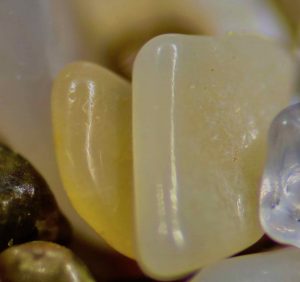
Focusing on individual sand grains, Kim was fascinated by the variety that exists in this world. She began to send out requests for sand from around the world. Added to her personal samples from Sandy Hook, NJ, were sand from Florida, New Zealand, the Dominican Republic, and other exotic locations. Kim was greatly encouraged by the support she received.
The variety of sand was instructive: New Zealand sand, for example, the second sample above, was from Rings Beach. It was notably glassy, with yellows, purples, and pinks. The next sample below, from Venice, Florida’s prime location on the Gulf Coast, is quartz mingled with fragments of fossils and crushed shells.
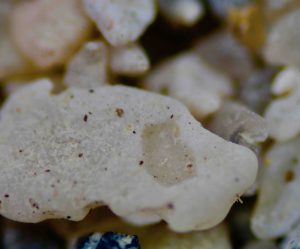
Throughout this process, Kim has been creatively reactive to her changing situation. As she presents in the poster session of the Symposium on Education, this has ultimately been an exercise in experimental design and development. Kim has learned how to adapt when the original plans did not work out and begun to network with a larger community.
She says,
At beginning of the sand and snowflake study, I hoped to obtain a few clear pictures of individual sand grains and snowflakes. Shortly after the study began, I became interested in learning about the different minerals that compose sand.
Currently, I have taken over 200 pictures of sand grains from over 35 different locations. This project has blossomed from a hobby into a passion.
Continuing her work, Kim would love for people to come see her at her poster to share ideas about how best to analyze the sand she has collected and to consult about techniques to catch and photograph snowflakes.
Another good reason to spend time wondering at the pictures in the poster conference. One final incentive, a biogenic sand sample from the Dominican Republic, where pink hues set it apart from U.S. East Coast sand.
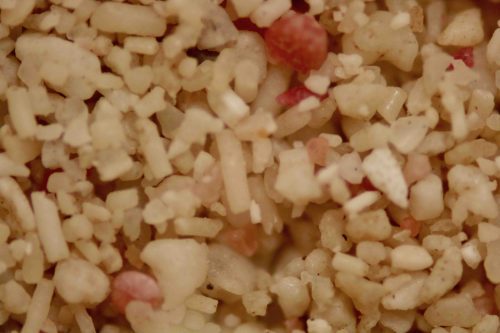
Is It Sand Or Is It Snow?: Nuggets from Today’s Poster Session
Today’s poster sessions starting at 4 p.m. will full of mysterious images. This is your opportunity to ask the researchers what the pictures are all about.
In the case of Morristown-Beard School sophomore Kim Magnotta’s poster (103) today, the question may be simply, what are pictures of sand doing at a meteorology conference?
There’s a good reason, of course, so go ahead and ask.

Magnotta jumped into microphotography hoping to capture images of snowflakes falling on Northern New Jersey. Starting her work during summer vacation, finding snow was difficult. Collecting samples from the Jersey Shore, she started photographing sand. It was also much easier perfecting her technique using subjects that did not melt. The first example shown above is primarily quartz and feldspar from Sandy Hook, NJ, including several uniquely large grains.

Focusing on individual sand grains, Kim was fascinated by the variety that exists in this world. She began to send out requests for sand from around the world. Added to her personal samples from Sandy Hook, NJ, were sand from Florida, New Zealand, the Dominican Republic, and other exotic locations. Kim was greatly encouraged by the support she received.
The variety of sand was instructive: New Zealand sand, for example, the second sample above, was from Rings Beach. It was notably glassy, with yellows, purples, and pinks. The next sample below, from Venice, Florida’s prime location on the Gulf Coast, is quartz mingled with fragments of fossils and crushed shells.

Throughout this process, Kim has been creatively reactive to her changing situation. As she presents in the poster session of the Symposium on Education, this has ultimately been an exercise in experimental design and development. Kim has learned how to adapt when the original plans did not work out and begun to network with a larger community.
She says,
At beginning of the sand and snowflake study, I hoped to obtain a few clear pictures of individual sand grains and snowflakes. Shortly after the study began, I became interested in learning about the different minerals that compose sand.
Currently, I have taken over 200 pictures of sand grains from over 35 different locations. This project has blossomed from a hobby into a passion.
Continuing her work, Kim would love for people to come see her at her poster to share ideas about how best to analyze the sand she has collected and to consult about techniques to catch and photograph snowflakes.
Another good reason to spend time wondering at the pictures in the poster conference. One final incentive, a biogenic sand sample from the Dominican Republic, where pink hues set it apart from U.S. East Coast sand.

Dr. Wakimoto's Lessons in Leadership
“One of you is likely to be standing here someday replacing me, “ AMS President Roger Wakimoto told the assembled 600+ attendees of the 18th AMS Student Conference Saturday morning in Phoenix.
The students looked at each other in the North Ballroom, but nobody could figure out who he was talking about. And neither could Dr. Wakimoto.
“Everyone is capable of being a leader,” he explained. “It’s whether or not you want to grasp the opportunity.”
For Wakimoto, who now serves as Vice-Chancellor for Research at the UCLA, this is wisdom grasped from life experience.
“As a student I was never chosen to lead anything,” the famed severe storm researcher told the students. “When they selected basketball teams, I was always the last person they would have selected.”
But at key moments in his life, enough people recognized Wakimoto’s capabilities even when he did not. Wakimoto didn’t plan to go to graduate school, but a professor “yanked me aside and told me it would be an incredible waste if I didn’t.”
Then, while comfortable in the academic enclave of his research at UCLA, people pushed him to try a leadership role, first at NCAR and then the National Science Foundation.
Wakimoto, who had to step suddenly into a now-finished two-year tenure as AMS President with the death of Matthew Parker, expressed the lessons of leadership in three simple words: transparency, integrity, and engagement.
The rest is unpredictable. “Forecasting the weather is easy; forecasting your future is impossible.”
Dr. Wakimoto’s Lessons in Leadership
“One of you is likely to be standing here someday replacing me, “ AMS President Roger Wakimoto told the assembled 600+ attendees of the 18th AMS Student Conference Saturday morning in Phoenix.
The students looked at each other in the North Ballroom, but nobody could figure out who he was talking about. And neither could Dr. Wakimoto.
“Everyone is capable of being a leader,” he explained. “It’s whether or not you want to grasp the opportunity.”
For Wakimoto, who now serves as Vice-Chancellor for Research at the UCLA, this is wisdom grasped from life experience.
“As a student I was never chosen to lead anything,” the famed severe storm researcher told the students. “When they selected basketball teams, I was always the last person they would have selected.”
But at key moments in his life, enough people recognized Wakimoto’s capabilities even when he did not. Wakimoto didn’t plan to go to graduate school, but a professor “yanked me aside and told me it would be an incredible waste if I didn’t.”
Then, while comfortable in the academic enclave of his research at UCLA, people pushed him to try a leadership role, first at NCAR and then the National Science Foundation.
Wakimoto, who had to step suddenly into a now-finished two-year tenure as AMS President with the death of Matthew Parker, expressed the lessons of leadership in three simple words: transparency, integrity, and engagement.
The rest is unpredictable. “Forecasting the weather is easy; forecasting your future is impossible.”
AMS Council Speaks Out on Federal Government Shutdown
At its meeting this morning in Phoenix, the AMS Council has released the following statement on the Federal government’s ongoing shutdown:
Those of us who study and predict the atmosphere are familiar with the impacts of uncertainty. Americans rely on weather forecasts, and they trust them to be reliable. Lives and livelihoods are saved or lost based on the timeliness and accuracy of a single weather warning.
Unfortunately, the current U.S. government shutdown—and the associated uncertainty—is now beginning to seriously set back efforts to better understand and forecast our environment and protect the nation’s health and prosperity. National Weather Service forecasters who work without pay during a shutdown, like their peers in other essential government services, experience mounting financial and emotional stress. Years of research are jeopardized when federal scientists cannot collect uninterrupted data. When government researchers no longer maintain collaborations with their peers in academia and industry, our nation, and each and every citizen, loses out.
The uncertain length of a shutdown adds to its costly and corrosive effects. Like a chain reaction, the impacts of a government shutdown ripple far beyond those who are furloughed and can impede development of new scientific technologies that are vital to our nation. Many non-government contract employees are already on forced time off without pay, and experiencing severe financial and personal hardship; we may lose the benefit of their knowledge and capabilities as a result.
Within days, the current shutdown may become the nation’s longest on record. Virtually all other nations have mechanisms to keep partisan disagreements from closing major segments of their governments for days or weeks. Without such a backstop, every shutdown means that the U.S. loses more ground to overseas competitors, as other nations take the lead in scientific leadership.
Our nation cannot afford to undermine its scientific enterprise for the sake of policy disagreement. The AMS urges our elected officials to come together and restore normal federal government operations as soon as possible, and we strongly suggest that partisan differences of opinion be given the time and attention they deserve without the unintended consequences of holding scientific research and related activities hostage.
The AMS Annual Meeting: Always a Need to Hear the Unheard
You’ve been here before. Those previous AMS Annual Meetings, for example, right here in Phoenix. You probably have some good memories of those. But this is not the sense of déjà vu we’re talking about.
Meteorologists, and indeed scientists of many disciplines, bridge the road from societal impacts to societal progress. As a result, you’ve been in this place before: “place” in the sense of what you study, what you say, and what you accomplish. It is all predicated on the premise that the most important people in the room are the people who are not, actually, in the room. The people who flee hurricanes and tsunamis, who dig out from snow and put out wildfires, whose coral reefs are blanching—they are notably absent from conference rooms and auditoriums as well as from laboratories, classrooms, and forecast offices. Yet in the places the work of these atmospheric and related sciences goes on, these unheard voices are the pleas that are being answered.
Science is a process of voices participating in discussions across many divides. Published papers in AMS journals spread ideas from many corners of the globe, just as our Annual Meeting brings together people and their findings from across borders.
As with international borders, so too with generational borders. Discussions in Phoenix this year originate from people who were once among us, but whose voices are now silenced. You can be sure that, as much as it hurts to lose a pioneering scientist such as, say, Doug Lilly, who died this past year, his voice is still very much in the room here due to all his students and all the people influenced by his work. In fact, anyone who takes advantage of opportunities to mentor other scientists is ensuring her voice will be in many rooms she’s never entered. This is the power of a collective enterprise such as AMS.
While answering the unheard is a specialty for this community, now we are about to get even better at it. First, we greatly miss our colleagues and friends from the Federal government who unfortunately must miss this AMS Annual Meeting. The opportunities of the week are reserved for the vast majority who made it to Phoenix as planned. But remember that we are used to speaking as best we can for voices of the missing. The voice we raise, and the waves we make, will undoubtedly be all the stronger if those who aren’t here are not forgotten.
But second, and ultimately more significantly, we will get better at including the voice of the unheard–by including them in the room. One of the great strengths of AMS president Roger Wakimoto’s theme this week is directly related to this chronic condition of sciences so intimately tied to societal need: “Understanding and Building Resilience to Extreme Events by Being Interdisciplinary, International, and Inclusive.”
That last of three “I’s” is telling. Inclusiveness promotes many voices by giving people a seat at the table. No longer can AMS represent every voice by assuming that the few can speak for the many. Inclusiveness is a theme of this meeting, of this year in AMS initiatives, and a pillar of AMS Centennial activities moving forward. For example, this year’s Inez Fung Symposium includes a panel on Tuesday on “Fostering Diverse Perspectives in Climate Science.”
This year’s meeting will be a success, all the more because you’re accustomed to acting like a typical meteorologist, listening to the people who can’t be, or haven’t typically been, in the room.